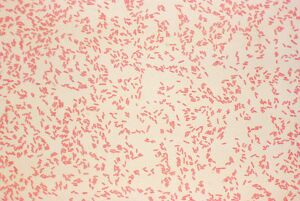Yersinia enterocolitica
Yersinia enterocolitica is a G- non-sporulating, facultatively anaerobic straight rod. It is pathogenic to humans and is the cause of human yersiniosis. The disease is transmitted alimentary through infected raw pork. It is widespread cosmopolitanly. The prevention is to avoid consuming badly roasted pork, or to observe hygiene after contact with the meat. The disease can be treated with antibiotics.
Morphology[edit | edit source]
Yersinia enterocolitica is a gram-negative straight rod that is only mobile at lower temperatures. Its size is 0.3–1.0 μm and 1.0–6.0 μm. It can be grown on conventional cultivation soils because it is easy to grow. It has no problem growing in a low glucose environment at 28°C. It is recommended to use selective soils for culturing bacteria from faeces. The ideal pH for growth is in a wide range of 4.6-9 with an optimal pH of 7-8.
Epidemiology[edit | edit source]
Yersinia enterocolitica was discovered by Schleifstein and Coleman in year 1939 in the USA. It has been a well-known pathogen in the last four decades. It occurs mainly in food, especially in raw pork, but has no problem surviving on fruits and vegetables in the refrigerator at lower temperatures. Most Y. enterocolitica isolates recovered from natural samples, including houses where animals are slaughtered or in butchers. They were non-pathogenic in nature and in water. Bio serotypes 4/O:3 are the most common cause of human yersiniosis, food poisoning caused by Y. enterocolitica is known cosmopolitanly.
Pathogenicity and virulence[edit | edit source]
Virulence is bound on the chromosome and on the plasmid. It is given by the invasiveness and penetration of the microbe into the cell. Food can enter the terminal ileum and appendix, where it penetrates cells and lymphatic tissues to which it has a particularly high affinity. Virulent strains multiply in macrophages and induce granuloma formation. Non-virulent strains are eliminated without penetrating the cells.
Clinical picture[edit | edit source]
We observe clinical signs from mild diarrhea to serious complications such as liver abscesses and post-infectious extraintestinal consequences. The main reservoir is pigs, which are asymptomatic carriers.
Disease[edit | edit source]
Manifestations of the disease in humans are different in children and adults. Children develop fever and diarrhea, where blood may appear. Abdominal pain is also typical in the right lumbar pit. In adults, we observe gastrointestinal infections and diarrhea. With long-term illness, secondary complications can occur and these are inflammations of the joints. An unusual case of infection manifesting as perianal ulcers and colon ulcers has also been observed. An individual can become infected from infected pork. Toxic bacteria produce a thermostable toxin at 25°C in milk. However, at 4°C they will not produce significant amounts of this toxin.
Therapy[edit | edit source]
Bacteremia requires antibiotic treatment. Tetracycline is used. Tests have shown that bacteria have a high degree of resistance to ampicillin and cephalothin. In the diagnostic laboratory, examinations of the stool, nodes, and appendix are performed. Immunochromatic test for the quantitative determination of serotypes O3 and O9 in a stool sample with a result within 1 hour. The test is highly sensitive and specific.
Prevention[edit | edit source]
Prevention against Yersinia enterocolitica and Yersinia pseudotuberculosis is to avoid eating undercooked pork or drinking unpasteurized milk. After contact with raw pork, it is recommended to wash your hands thoroughly with soap.
Links[edit | edit source]
Related articles[edit | edit source]
References[edit | edit source]
- BEDNÁŘ, Marek – SOUČEK, Andrej – FRAŇKOVÁ, Věra. Lékařská mikrobiologie : Bakteriologie, virologie, parazitologie.. 1. edition. Praha. 1999. . ISBN 8023802976.
- JULÁK, Jaroslav. Úvod do lékařské bakteriologie. 1. edition. Praha. 2006. ISBN 80-246-1270-4.


